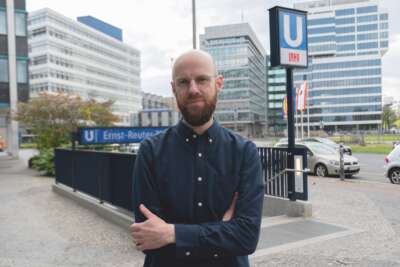Urban Future

- Felix Petersen, Head of Europe at Spin
- Photos: Spin

Based in Lisbon, Felix Petersen is a serial entrepreneur who founded polemic opinionsharing platform Amen (bought by Tape TV) and geosocial networking site Plazes (bought by Nokia). He’s also been around micromobility since its early days. His last role was co-founder of Circ, an e-scooter company that scored record series-A funding in Europe, before its acquisition by Bird. He then joined Ford Motor Company’s micromobility subsidiary Spin as Head of Europe, charged with spinning the wheel this side of the Atlantic.
As an old hand in a new industry, Felix discusses his work launching Ford’s Spin in Europe, explains why we are still early in the micromobility paradigm, and talks about how cities have started looking positively towards the future.
Tell us about your company.
Spin is an interesting animal in the micromobility space because we’re not a venture-backed company but a fully owned subsidiary of Ford. They purchased it in 2018, when it was a bike-sharing company. The founder is still with us today – he started the first dock-less bike scheme in Seattle from an urban planning approach. When it was bought by Ford they switched to scooters. Our service is one of the biggest in the US, and serves 75 cities across 12 countries at the moment.
In 2020 we started in Europe. We started in Germany, and we’re also in the UK now. We’re also launching in Spain. Europe has cities that lend themselves very well to micromobility, building on a strong bike culture.
What phase of micromobility are we in?
Very early. I used to have this Nokia communicator around the turn of the century. I was telling people, “Look guys, this is a computer, it can do everything. Why don’t you also have one? Why can’t I do my banking transactions on this?” It took 15 years but today everyone has a smartphone in their pocket. Now there are lots of things that aren’t even possible without one. With micromobility it’s the same thing. These dockless bike or scooter schemes have not been possible for very long. First you needed everyone to have a smartphone. Then, the data needed to be cheap enough, and each vehicle had to carry what we call an “IoT box”– internet of things – including SIM card and GPS. That’s only been possible for a few years. This is new. That’s why this is still very much in the beginning. We’re seeing a tipping point in terms of cities, where people start imagining… Cities have switched from being against cars, and using crude mechanisms like taxing fuel to make them more expensive. Now they are formulating positive strategies. Like the 15-minutecity scheme in Paris, where everyone should be able to live their lives within 15 minutes of their home. In Lisbon, car parks have become parks. Cities have switched to a positive vision, that their quality of life can be better. It’s less of an ideological war against cars, and more that other options are available now. There’s been a shift to investment, and thinking about the next hundred years.
And the new vehicles are far less complex. The scooters have fewer parts, and these are much cheaper than those for a car. Electric bikes for example are just made with conventional bike parts plus a motor. And bike companies can become mobility companies; the lines are blurring. There will be more and more vehicles that also blur the lines, like pods – we don’t even know what they’ll be called. You’re seeing cargo bikes that cost as much as a car. We’re seeing options more aligned with our footprint, that carry much less weight than a car, under 500 kg. All this is coming together in a really cool way.
But this never happens overnight. What we usually get wrong with the future is not what happens, but when it happens and how. I was listening to a podcast about the first new economy bubble, the dotcom boom, around the turn of the millennium. Most of the companies that went up in flames all represented concepts that exist very profitably now. For example, pet food delivery provided by Pets.com is now a huge industry. It’s just that back then, it was absolutely obvious to the founders that this was going to happen. But they didn’t understand that people weren’t ready. The public was still not so cool with using credit cards, etc. Those companies had thousands of clients, when they needed millions. Now, it’s the same with micromobility, regarding the potential and people’s readiness to adopt.
What about criticisms that e-scooters were far from the sustainability solution they claimed to be? For example that they broke easily and were thrown into landfill?
Much of it’s true, or was true. There was the rush to grow, be the biggest, grow the fastest. Back then they were basically toys dumped on the streets. Now the batteries are exchanged so you don’t dump the whole scooter when the battery runs out. They last longer. And many materials are reused. We have 70% of the scooter that is sustainable, and 98% of waste is recycled. The companies didn’t do themselves any favours back then. It was clear it could be done better but they were thinking of speed and customers. Now the industry has this reputation and rightly so. It was a home-made reputational stain that the sector brought upon itself, but today it’s not true any more.
And something you have to bear in mind is what’s being substituted. Two out of three riders said it replaced a single car trip for them. You have to take it all into account, the net CO2 emissions reduction. That’s through supply and recycling, operation, and what it replaces. Then, it’s not just about CO2, but space, quality of life, noise pollution, all these things… Still, our industry must provide the answers. We have to be not just carbon-neutral but negative.
But if you take a step back and see a city with people zipping around on small vehicles charged with renewable energy, and most parking spaces converted to café seating or green spaces, then you see the direction of the sustainable future. What’s the alternative? We don’t have one for redesigning our cities. Small electric vehicles will play a role in this. There will be different models – subscriptions or pay-as-you-go – for different types of vehicles. It will depend on what you want to do – going to a meeting, shopping, picking up the kids. That’s the cool thing about the car: it’s expensive and big, but very versatile. To substitute that, we need the right mode for every use case. The vision needs to be that compared to what you spend on your private car today, for a lower budget you can get all use cases out of the shared system. Going to IKEA, for example, will require shared vans. We still need a simple way at a low price to go from Berlin to the Baltic Sea on the weekend. That’s what we forget, it’s all fine in the urban core, but we have to think about rural zones and other use cases.


Has the Covid-19 pandemic been an opportunity?
Some venture-financed companies immediately took their vehicles off the street. But during the coronavirus these vehicles were actually a great way to get around. It’s socially distanced, there were pop-up bike lanes… Some of the other players weren’t there when they were needed most. But in the US we were the only company to say, “Let’s keep operating.” And we gave free rides to health workers. We in fact saw more rides, longer rides. During the first lockdown in the UK, our rides didn’t go down, but up.
What do you say to those who argue that micromobility represents a continual erosion of public services in favour of private tech schemes?
That was very true in the first phase, when scooters weren’t explicitly regulated. But the city is in control of what happens on their public roads, on their public pavements. And now the tenders from cities are imposing exactly that. They’re taking into account that companies are providing services and need to be paid. But they impose sustainability clauses and carbon demands now, as well as price fixing. They reduce competition, and ensure the right number of scooters on the roads. They might choose three operators, and 5,000 scooters, say. And demand that we give them data, and guarantee representation in underserved areas, so companies don’t just avoid neighbourhoods with low adoption rates.
What are the factors that inspire adoption rates of micromobility solutions in cities?
Interestingly we’ve seen that cities with similar population densities, which should be similar on paper, play out quite differently, because of cultural aspects. In southern Europe for example there’s a less strong bike culture than the north, and people easily take up scooters. Whereas in northern Europe, people grew up on a bike and feel more comfortable with that.

Which cities have already a strong mobility concept for the future?
As I already mentioned, Paris with its clearly stated vision of the 15-minute city. You’re going to be able to reach everything within 15 minutes by walking or taking your bike. This is about decentralised neighbourhoods with a strong mix of working, living, leisure options – all combined with sustainable and affordable transport for everyone, with public transport the backbone of it. But what I really like about Paris is they have a clearly stated vision. So it’s not about what we don’t want, or sanctioning certain behaviours or taxing certain vehicles. It’s a sustainable vision for the future.
The other city that has a very interesting technical approach is Helsinki. They’ve established a MAAS concept, so mobility as a service. If you want to get around you have to integrate yourself onto their platform so all the services can be combined. Already now through an app like Whim, people can choose between subscriptions. The basic level is I think 59 euros for public transport, bikes, and a certain amount of taxi rides. It goes all the way up to a 450-euro subscription including unlimited use of all modes of transport including shared and rental cars. It’s still cheaper than individual car ownership and much more sustainable. It seems expensive but when you think of the total cost of ownership for a car then you are in very similar dimensions. But this is interesting
because it really takes care of all mobility needs and all use cases. That’s an example of a solid technical solution combined with a good vision.
What are your predictions?
One thing that will be interesting is rural areas. The car has been an incredible tool for access and inclusion. It still creates incredible opportunities for people, and in rural areas it’s a necessity. Micromobility models are easy to make work in dense urban cores. But how they might extend to underserved areas could be through shuttle services, a hybrid between buses and taxis. That kind of thing is going to be really interesting. What will be the Android of micromobility, that brings it to everyone and not just big cities? Then there’s autonomous vehicles. These go through hype cycles – a few years ago people were saying it’s just around the corner and now they realise it’s harder than they thought. A robotaxi that takes you wherever you want automatically. It will come.
But the main thing is the vision. Once you open your eyes to see the space taken by cars in our cities, you think, how could our cities be in the future? If you look at every car park, and imagine it as a space to put something. That’s going to be really interesting.
What’s the role of the car in the future of mobility?
Obviously, the car industry is still at the core of mobility. There are more than 50m cars sold every year worldwide so it’s clearly a product with a lot of demand. The first thing that will change is individual car ownership in the cities, but that doesn’t mean that outside of urban cores, in rural areas, or also for shared mobility services in the city, that we don’t need cars. They will be moving to other forms of engine, like electric and fuel cell, but they will be around. And they will play an important role, but in a shared way. Then, another thing we’ll see is more diversified types of vehicles catering to specific needs. For example, I need to travel a lot between countries, and flying is not exactly climate-neutral. Actually outside of cities, cars can be a better way to get around. So I’m planning a kind of slow business travel project, where I put my office in a van and just go on tour around Europe, between Spin’s different markets, and work from the van. So cars will stay around, but not in our current model of individual car ownership, at least not in cities.












